|
|
|
|
当前位置:首页 >> 教学资源 >> 教学园地 >> 变质岩石学
|
|
Metamorphic Rock Textures
发布时间:2013/7/25 15:34:00 点击次数:601 次
|
|
|
| Metamorphic rocks exhibit a variety of textures. These can range from textures similar to the original protolith at low grades of metamorphism, to textures that are purely produced during metamorphism and leave the rock with little resemblance to the original protolith. Textural features of metamorphic rocks have been discussed in the previous lecture. Here, we concentrate on the development of foliation, one of the most common purely metamorphic textures, and on the processes involved in forming compositional layering commonly observed in metamorphic rocks.
Foliation
Foliation is defined as a pervasive planar structure that results from the nearly parallel alignment of sheet silicate minerals and/or compositional and mineralogical layering in the rock. Most foliation is caused by the preferred orientation of phylosilicates, like clay minerals, micas, and chlorite. Preferred orientation develops as a result of non-hydrostatic or differential stress acting on the rock (also called deviatoric stress). We here review the differences between hydrostatic and differential stress.
|
Stress and Preferred Orientation
Pressure increases with depth of burial, thus, both pressure and temperature will vary with depth in the Earth. Pressure is defined as a force acting equally from all directions. It is a type of stress, called hydrostatic stress or uniform stress. If the stress is not equal from all directions, then the stress is called a differential stress. Normally geologists talk about stress as compressional stress. Thus, if a differential stress is acting on the rock, the direction along which the maximum principal stress acts is called σ1, the minimum principal stress is called σ3, and the intermediate principal stress direction is called σ2. Note that extensional stress would act along the direction of minimum principal stress. |
If differential stress is present during metamorphism, it can have a profound effect on the texture of the rock.
- Rounded grains can become flattened in the direction of maximum compressional stress.
|
 |
- Minerals that crystallize or grow in the differential stress field may develop a preferred orientation. Sheet silicates and minerals that have an elongated habit will grow with their sheets or direction of elongation orientated perpendicular to the direction of maximum stress.
|
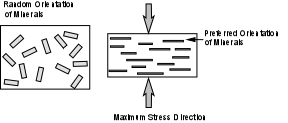 |
This is because growth of such minerals is easier along directions parallel to sheets, or along the direction of elongation and thus will grow along σ3 or σ2, perpendicular to σ1.
Since most phyllosilicates are aluminous minerals, aluminous (pelitic) rocks like shales, generally develop a foliation as the result of metamorphism in a differential stress field.
Example - metamorphism of a shale (made up initially of clay minerals and quartz) |
Shales have fissility that is caused by the preferred orientation of clay minerals with their {001} planes orientated parallel to bedding. Metamorphic petrologists and structural geologists refer to the original bedding surface as S0. |
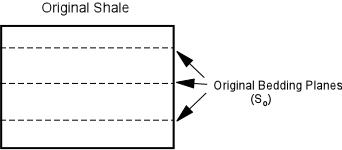 |
- Slate Slates form at low metamorphic grade by the growth of fine grained chlorite and clay minerals. The preferred orientation of these sheet silicates causes the rock to easily break planes parallel to the sheet silicates, causing a slatey cleavage.
|
Note that in the case shown here, the maximum principle stress is oriented at an angle to the original bedding planes so that the slatey cleavage develops at an angle to the original bedding. The foliation or surface produced by this deformation is referred to S1. |
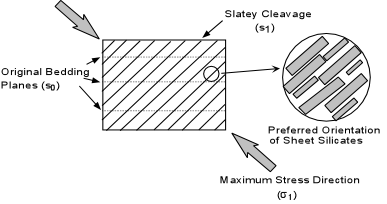 |
- Schist - The size of the mineral grains tends to enlarge with increasing grade of metamorphism. Eventually the rock develops a near planar foliation caused by the preferred orientation of sheet silicates (mainly biotite and muscovite). Quartz and feldspar grains, however show no preferred orientation. The irregular planar foliation at this stage is called schistosity
|
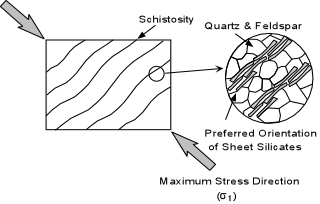 |
- Gneiss As metamorphic grade increases, the sheet silicates become unstable and dark colored minerals like hornblende and pyroxene start to grow.
|
These dark colored minerals tend to become segregated into distinct bands through the rock (this process is called metamorphic differentiation), giving the rock a gneissic banding. Because the dark colored minerals tend to form elongated crystals, rather than sheet- like crystals, they still have a preferred orientation with their long directions perpendicular to the maximum differential stress. |
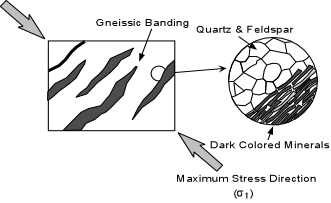 |
- Granulite - At the highest grades of metamorphism most of the hydrous minerals and sheet silicates become unstable and thus there are few minerals present that would show a preferred orientation. The resulting rock will have a granulitic texture that is similar to a phaneritic texture in igneous rocks.
|
 |
|
In general, the grain size of metamorphic rocks tends to increase with increasing grade of metamorphism, as seen in the progression form fine grained shales to coarser (but still fine) grained slates, to coarser grained schists and gneisses.
Metamorphism and Deformation
Most regionally metamorphosed rocks (at least those that eventually get exposed at the Earth's surface) are metamorphosed during deformational events. Since deformation involves the application of differential stress, the textures that develop in metamorphic rocks reflect the mode of deformation, and foliations or slatey cleavage that develop during metamorphism reflect the deformational mode and are part of the deformational structures. |
| The deformation involved in the formation of fold-thrust mountain belts generally involves compressional stresses. The result of compressional stress acting on rocks that behave in a ductile manner (ductile behavior is favored by higher temperature, higher confining stress [pressure] and low strain rates) is the folding of rocks. Original bedding is folded into a series of anticlines and synclines with fold axes perpendicular to the direction of maximum compressional stress. These folds can vary in their scale from centimeters to several kilometers between hinges. Note that since the axial planes are oriented perpendicular to the maximum compressional stress direction, slatey cleavage or foliation should also develop along these directions. Thus, slatey cleavage or foliation is often seen to be parallel to the axial planes of folds, and is sometimes referred to axial plane cleavage or foliation. |
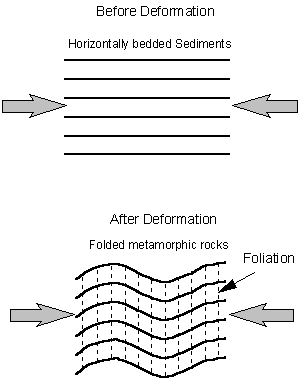 |
|
Metamorphic Differentiation
As discussed above, gneisses, and to some extent schists, show compositional banding or layering, usually evident as alternating somewhat discontinuous bands or layers of dark colored ferromagnesian minerals and lighter colored quartzo-feldspathic layers. The development of such compositional layering or banding is referred to as metamorphic differentiation. Throughout the history of metamorphic petrology, several mechanisms have been proposed to explain metamorphic differentiation. |
- Preservation of Original Compositional Layering. In some rocks the compositional layering may not represent metamorphic differentiation at all, but instead could simply be the result of original bedding. For example, during the early stages of metamorphism and deformation of interbedded sandstones and shales the compositional layering could be preserved even if the maximum compressional stress direction were at an angle to the original bedding.
|
In such a case, a foliation might develop in the shale layers due to the recrystallization of clay minerals or the crystallization of other sheet silicates with a preferred orientation controlled by the maximum stress direction. |
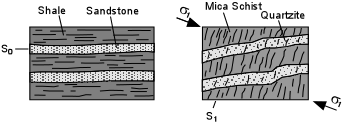 |
Here, it would be easy to determine that the compositional layers represented original bedding because the foliation would cut across the compositional layering. |
In highly deformed rocks that have undergone both folding and shearing, it may be more difficult to determine that the compositional layering represents original bedding. As shearing stretches the bedding, individual folded beds may be stretched out and broken to that the original folds are not easily seen. |
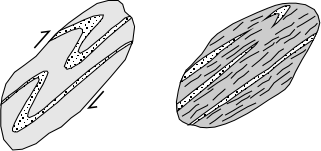 |
Similarly, if the rock had been injected by dikes or sills prior to metamorphism, these contrasting compositional bands, not necessarily parallel to the original bedding, could be preserved in the metamorphic rock.
- Transposition of Original Bedding. Original compositional layering a rock could also become transposed to a new orientation during metamorphism. The diagram below shows how this could occur. In the initial stages a new foliation begins to develop in the rock as a result of compressional stress at some angle to the original bedding. As the minerals that form this foliation grow, they begin to break up the original beds into small pods. As the pods are compressed and extended, partly by recrystallization, they could eventually intersect again to form new compositional bands parallel to the new foliation.
|
- Solution and Re-precipitation. In fine grained metamorphic rocks small scale folds, called kink bands, often develop in the rock as the result of application of compressional stress. A new foliation begins to develop along the axial planes of the folds. Quartz and feldspar may dissolve as a result of pressure solution and be reprecipitated at the hinges of the folds where the pressure is lower. As the new foliation begins to align itself perpendicular to σ1, the end result would be alternating bands of micas or sheet silicates and quartz or feldspar, with layering parallel to the new foliation.
|
- Preferential Nucleation. Fluids present during metamorphism have the ability to dissolve minerals and transport ions from one place in the rock to another.
|
Thus felsic minerals could be dissolved from one part of the rock and preferentially nucleate and grow in another part of the rock to produce discontinuous layers of alternating mafic and felsic compositions. |
 |
- Migmatization. As discussed previously, migmatites are small pods and lenses that occur in high grade metamorphic terranes that may represent melts of the surrounding metamorphic rocks. Injection of the these melts into pods and layers in the rock could also produce the discontinuous banding often seen in high grade metamorphic rocks. The process would be similar to that described in 4, above, except that it would involve partially melting the original rock to produce a felsic melt, which would then migrate and crystallize in pods and layers in the metamorphic rock. Further deformation of the rock could then stretch and fold such layers so that they may no longer by recognizable as migmatites.
|
|
|
Examples of questions on this material that could be asked on an exam
- Define the following: (a) foliation, (b) hydrostatic stress, (c) differential stress, (d) preferred orientation (e) metamorphic differentiation.
- Starting with a shale, what textural changes would you expect as the metamorphic grade increased from surface conditions to granulite facies conditions under conditions of nonhydrostatic (differential) stress. Explain why the textural changes occur.
- What is an axial plane cleavage or foliation and how and why does it form during metamorphism?
- What are four ways that compositional layering that was not originally present could form during metamorphism?
|
|
|
|
|
|
|
|